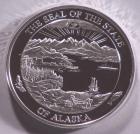2014 Moose!
2014 Moose One Ounce Silver Proof


Click images for enlargements
Krystelle Masters, a 15 year old from Anchorage, submitted the winning design for the 2014 Official State Medallion.
Total one ounce proof mintage: 1,862
Current List Price: $225.00
One ounce of .999 silver, the piece features a bull moose with a map image of Alaska in the background.
Please call for availability.
Moose are the world's largest members of the deer family. Moose are generally associated with the northern forests in North America, Europe and Russia. They're most abundant in recently burned areas that contain willow and birch shrubs, on timberline plateaus, or along major rivers.
Moose are long-legged and heavy-bodied with a drooping nose, a "bell" or dewlap under the chin, and a small tail. Their color ranges from golden brown to almost black, depending upon the season and the age of the animal.
Newborn calves weigh 28-35 pounds and within five months grow to over 300 pounds. Males in prime condition weight from 1,200 to 1,600 pounds. Adult females weigh 800 to 1,300 pounds. Only the bulls have antlers. Moose occasionally produce trophy-size antlers when they are 6 or 7 years old, with the largest antlers grown at approximately 10 to 12 years of age. In the wild, moose rarely live more than 16 years of age.
During fall and winter, moose consume large quantities of willow, birch, and aspen twigs. Spring is the time of grazing as well as browsing. Moose eat a variety of foods, particularly sedges, ezuisturn (horsetail), pondweeds, and grasses. During the summer, moose feed on vegetation in shallow ponds, forbs, and the leaves of birch, willow and aspen trees. Most moose make seasonal movements to calving, rutting, and wintering areas. They travel anywhere from only a few miles to as many as 60 miles during transitions.
